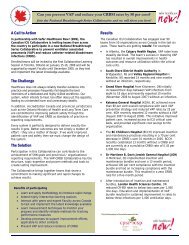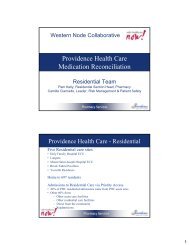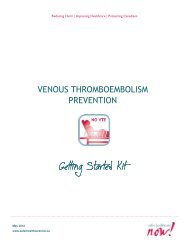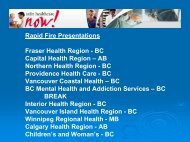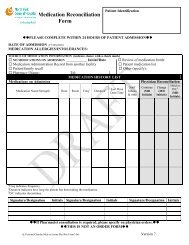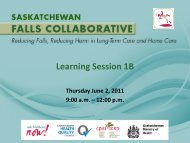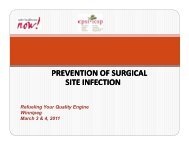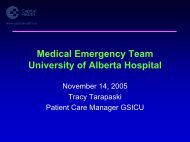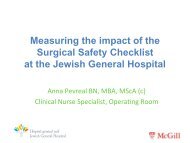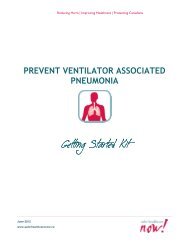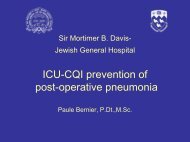Medication Reconciliation in Canada: Raising the Bar (2012) - CIHI
Medication Reconciliation in Canada: Raising the Bar (2012) - CIHI
Medication Reconciliation in Canada: Raising the Bar (2012) - CIHI
- No tags were found...
Create successful ePaper yourself
Turn your PDF publications into a flip-book with our unique Google optimized e-Paper software.
This assessment and validation of compliance contributes to improv<strong>in</strong>g quality and safety, mitigatesrisk, contributes to enabl<strong>in</strong>g <strong>the</strong> organization and/or jurisdiction to achieve its priorities, andpromotes organizational effectiveness through identification of areas of strength and areas forimprovement.First <strong>in</strong>troduced <strong>in</strong>to <strong>the</strong> accreditation program <strong>in</strong> 2005, Required Organizational Practices (ROPs)are evidence-based practices that mitigate risk and contribute to improv<strong>in</strong>g <strong>the</strong> quality and safetyof health services. In order to ensure <strong>the</strong>ir cont<strong>in</strong>u<strong>in</strong>g relevance, all ROPs are developed and<strong>in</strong>tegrated <strong>in</strong>to <strong>the</strong> program with <strong>in</strong>put from health care experts <strong>in</strong>clud<strong>in</strong>g practitioners, researchers,policy-makers, m<strong>in</strong>istries of health personnel, academics, and health services providers at <strong>the</strong>prov<strong>in</strong>cial, territorial, and national levels. Exist<strong>in</strong>g <strong>in</strong>itiatives and priorities with<strong>in</strong> each jurisdictionare important considerations <strong>in</strong> <strong>the</strong> development process. Each ROP is supported by research,<strong>in</strong>clud<strong>in</strong>g evidence that <strong>the</strong> safety practice contributes to <strong>the</strong> reduction of health care costs.<strong>Medication</strong> reconciliation was <strong>in</strong>troduced <strong>in</strong>to <strong>the</strong> Accreditation <strong>Canada</strong> program <strong>in</strong> 2005 forassessment <strong>in</strong> 2006 based on <strong>the</strong> recommendations of <strong>the</strong> Accreditation <strong>Canada</strong> Patient SafetyAdvisory Committee. The emerg<strong>in</strong>g evidence demonstrated that medication reconciliation reducedmedication errors. Two ROPs are <strong>in</strong>cluded <strong>in</strong> many of <strong>the</strong> Accreditation <strong>Canada</strong> standards. Theseare: <strong>Medication</strong> <strong>Reconciliation</strong> at Admission and <strong>Medication</strong> <strong>Reconciliation</strong> at Transfer or Discharge.These service-level ROPs cover <strong>the</strong> detailed steps of <strong>the</strong> medication reconciliation process, such ascomplet<strong>in</strong>g a Best Possible <strong>Medication</strong> History and communicat<strong>in</strong>g up-to-date medication lists to <strong>the</strong>next care provider.Recogniz<strong>in</strong>g <strong>the</strong> resources, <strong>in</strong>frastructure, and process change challenges faced by organizationsacross <strong>Canada</strong> <strong>in</strong> <strong>the</strong> successful implementation of medication reconciliation, <strong>the</strong> Qmentumaccreditation program requirements for medication reconciliation were scaled back <strong>in</strong> 2008. Thecurrent approach is detailed <strong>in</strong> <strong>the</strong> Accreditation <strong>Canada</strong> Leadership Standards as <strong>the</strong> <strong>Medication</strong><strong>Reconciliation</strong> as an Organizational Priority ROP, which requires <strong>the</strong> follow<strong>in</strong>g:• <strong>Medication</strong> reconciliation is implemented <strong>in</strong> one client service area at admission and one clientservice area at transfer or discharge.• There is a documented plan to implement medication reconciliation throughout <strong>the</strong> organization,which <strong>in</strong>cludes locations and timel<strong>in</strong>es.In order to facilitate implementation, <strong>the</strong> Accreditation <strong>Canada</strong> medication reconciliation ROPswere re-exam<strong>in</strong>ed <strong>in</strong> close partnership with ISMP <strong>Canada</strong>, CPSI, and stakeholders from across<strong>Canada</strong>. As a result, <strong>the</strong> ROPs were customized with specific guidel<strong>in</strong>es and tests for compliance.In 2010-2011, <strong>the</strong> <strong>Medication</strong> <strong>Reconciliation</strong> at Admission ROP was adjusted to <strong>in</strong>corporate <strong>the</strong>unique requirements of ambulatory/outpatient services, home/community services, and emergencydepartments. In 2011-<strong>2012</strong>, <strong>the</strong> <strong>Medication</strong> <strong>Reconciliation</strong> at Transfer or Discharge ROP wasenhanced to clarify <strong>the</strong> important process steps for acute care, long-term care, ambulatory/outpatient services, and home/community services.A Snapshot of <strong>Medication</strong> <strong>Reconciliation</strong> <strong>in</strong> <strong>Canada</strong>The Accreditation <strong>Canada</strong> ROPsS<strong>in</strong>ce <strong>the</strong> Qmentum accreditation program was <strong>in</strong>troduced <strong>in</strong> 2008, <strong>the</strong>re has been a gradualimprovement <strong>in</strong> organizational performance on medication reconciliation ROPs across <strong>the</strong>cont<strong>in</strong>uum of care. Of <strong>the</strong> current 37 Qmentum program ROPs, <strong>the</strong> medication reconciliationROPs had <strong>the</strong> greatest improvement <strong>in</strong> <strong>the</strong> past year. As shown <strong>in</strong> Figure 4, Canadian health care10 <strong>Medication</strong> <strong>Reconciliation</strong> <strong>in</strong> <strong>Canada</strong>: Rais<strong>in</strong>g <strong>the</strong> <strong>Bar</strong>



